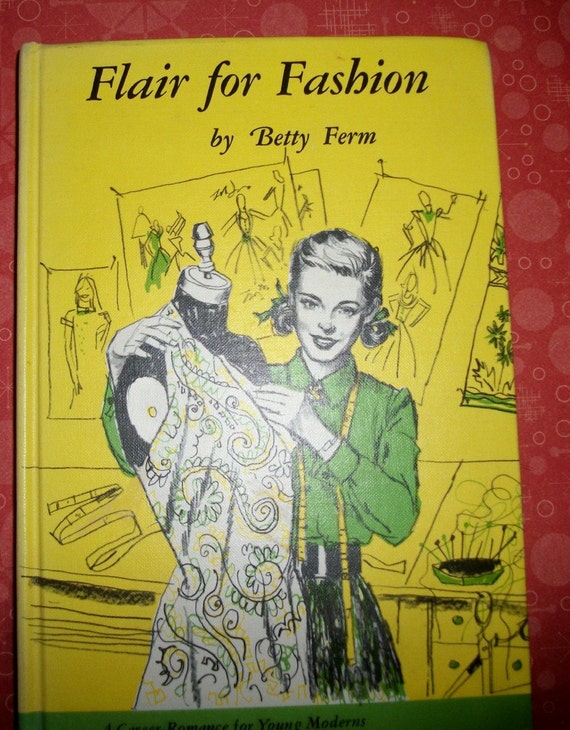Flair for Fashion
Betty Ferm
1967, Julian Messner
A Career Romance for Young Moderns
Her black hair was brushed
to perfection and capped her head in a casual, to the shoulder length. A new
white lace blouse enlivened the dark V of her jacket, and just the right amount
of powder duster the tip of her slightly tilted nose.
And thus are we introduced to Ellen Matthews, en route to
New York to claim her prize from fashion school; a six-month internship with Countess
Gardella at the House of Etienne.
She gave the gown a
pin-tucked shirt waist bodice with a long, cuffed sleeve. The suggested fabric
to be used was chiffon, with a low-cut matching colored slip. She added a
billowing skirt and indicated that the half-inch belt was to have a round buckle
made of the same chiffon.
This design wins her the internship, and is later dubbed
Black Magic. It not only wins Ellen her shot at New York success, it will
affect all her relationships at the House of Etienne. Starting with the Countess’s son, Tony. Because the Countess is ill when Ellen
reaches New York, and Tony is in charge. And her introduction to Tony is to overhear
him say he needs an experienced assistant, not “some callow kid who’s still wet
behind the ears.”
Meanwhile, in Ellen’s personal life, she’s bunking with conveniently
placed relative Aunt Laura, who lives in New York and is largely dismissed by
Ellen and her cozy nuclear family for being a finicky spinster. Already
interested in the Saint Louis ingénue is handsome blond ad man Bill Jennings,
whose company handled the contest for the House of Etienne. Bill’s a slick native New Yorker whose innate
sneakiness fascinates and repels Ellen in equal amounts. And of course, she ends up with a thing for
her dark, suave, faintly French boss, Tony.
Extreme amounts of clothing porn. Ferm describes what virtually everyone is
wearing in virtually every scene, and makes it clear that this is Ellen’s
fascination in life. Which is
great.
He was very handsome
in a black mohair suit with a woven silk tie. He wore a French-cuffed white
shirt with jeweled cuff links that matched his tie stud….
The descriptions are rather flat and overdone. This side is rather dull, for once.
But the motivations, and the tale of a young, rather naïve girl
thinking over her instinctive reactions to various situations – those are
wonderful. At one point, Ellen giggles
at the complicated process of ordering wine, and Bill tells her something she
had never considered before – that the fashion world involved more than
creative design, that ordering wine and being a social creature was part of the
business as well. In another fine
moment, Ellen’s assumptions about a fat friend – and about her boring, old maid
aunt - are exploded. Just as Ellen is mentally giving both women – one thin and
colorless, the other fat and dressed in loud patterns – a makeover, fat Mrs.
Boorman stuns her:
“Of course,” Mrs.
Boorman remarked, as they sat down at the table, “I could look even slimmer if
I wore solid colors.” Ellen almost dropped her tomato juice. It had never occurred
to her that Mrs. Boorman understood that.
She had assumed the heavy-set woman chose her flamboyant clothes from a
lack of judgement.
Mrs. Boorman continues that she kept up with the styles for
years, obediently changing with the times to suit each era.
“Then I decided to
take a stand. I picked the colorful dresses I liked best and stuck with them.
My daughters are horrified, but I’m happy.”
The romances were dull, the 1960’s swinging New York scenes
hysterical –
Greenwich Village was
alive with activity. Ellen caught glimpses of a dungareed girl with one blond
braid down her back, a thin, bearded fellow with a canvas under his arm, a
couple swaying jerkily outside a nightclub to a drum beat that echoed savagely
from within…
- and Ellen’s career plots were as predictable as the
romances. But the underlying
characterizations were very good, and the ideas good. The larger teen romance itself was just not
good.
Links
Kirkus review



